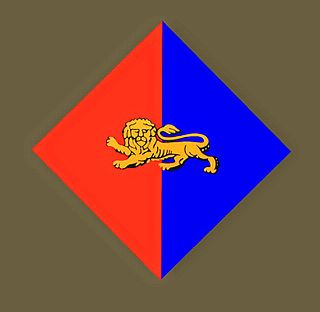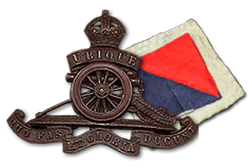
The II Corps was an army corps of the British Army formed in both the First World War and the Second World War. There had also been a short-lived II Corps during the Waterloo Campaign.

1st Army Group Royal Artillery was a brigade-sized formation organised by Britain's Royal Artillery during World War II to command medium and heavy guns. It served in the final stages of the Tunisian Campaign and throughout the Italian Campaign. It reformed in the Territorial Army in the 1950s to command air defence units.
1st Anti-Aircraft Brigade was an Air Defence formation of the British Army, during the Second World War, and served in the Battle of France and during The Blitz. It then transferred to the Middle East, where it defended the Eighth Army's lines of communication during the final phases of the North African Campaign.
The North Midland (Staffordshire) Heavy Battery was a Territorial Force (TF) unit of the Royal Garrison Artillery (RGA) formed in Staffordshire in 1908. It fought on the Western Front during World War I. Converted to medium artillery in the 1920s, the unit took part in the Battle of France and Dunkirk Evacuation in the early part of World War II, before returning to action in North Africa and Italy, and finally in North West Europe.
The 1st Fife Artillery Volunteers, later the Highland (Fifeshire) Heavy Battery, was a volunteer unit first recruited in Fifeshire, Scotland, in 1860, which fought on the Western Front in the First World War. Its successor units expanded recruitment to Aberdeenshire and again fought in North West Europe, during the Second World War.
The London Heavy Brigade, Royal Garrison Artillery was a unit of the British Territorial Force formed in 1908. It fought on the Western Front during World War I, and its successors served in the Mediterranean and North-West Europe theatres during World War II.

The 56th Anti-Tank Regiment was a Territorial Army unit of the British Army's Royal Artillery (RA), which converted from the 4th Battalion, King's Own Royal Regiment (Lancaster). During the Second World War, it first served with the 42nd Division in the Battle of France and Dunkirk evacuation in May–June 1940. In 1942, it was sent to join the 70th Infantry Division in India, where it was converted into a Light Anti-Aircraft/Anti-Tank Regiment. In this guise, it served in the Burma Campaign, mainly with the 5th Indian Infantry Division. It reconverted to the anti-tank role in late 1944 and in June 1945 it returned to India as a training unit. It continued serving in the TA postwar until 1961, when it re-merged into the King's Own.

The Metropolitan Artillery Volunteers was a part-time unit of the British Volunteer Force formed in the London area in 1861. It was designated the 3rd Middlesex Artillery Volunteers and went on to become the 5th London Brigade, Royal Field Artillery in the Territorial Force. It provided two active service units in World War I, which saw action on the Western Front. Just before World War II it again spun off a duplicate regiment, each taking the '5th London' subtitle. Both regiments saw widely varied service during the war. The regiment later provided an airborne artillery unit in the Territorial Army of the 1950s.

The 1st Devonshire Artillery Volunteers and its successor units served in the British Army's Reserve Forces from 1859 to 1961. During World War I it carried out garrison duty in British India but went on to see active service in the Third Anglo-Afghan War. Converting to an air defence role before World War II its units participated in the Norwegian campaign and the Dunkirk evacuation, the Battle of Britain and then the campaigns in North Africa, Italy, and Burma
The 1st Searchlight Regiment, Royal Artillery was an air defence unit of the British Army from 1920 until 1954. Originally formed in the Royal Engineers (RE), it was transferred to the Royal Artillery (RA) at the start of World War II. It fought with distinction in the defence of Calais during the Battle of France, in which it was virtually destroyed. Reformed, it helped to protect the cities of South Wales from the Luftwaffe during The Blitz, and later defended the South Coast of England against Fighter bomber and V-1 flying bomb attacks. It went to North West Europe to defend Antwerp during the final stages of the war, and served in the Gibraltar garrison postwar.

73rd Heavy Anti-Aircraft Regiment, Royal Artillery was a West Midlands-based volunteer air defence unit of Britain's Territorial Army (TA) raised in 1937. During World War II, it served in the Battle of France, The Blitz, Egypt, Sicily and Italy. Postwar, its successor regiments continued to serve until 1967, and a battery descended from the regiment forms part of today's Army Reserve

The 2nd Cinque Ports Artillery Volunteers was a part-time unit of the British Army's Royal Artillery from 1890 to 1955. Raised as coastal defence artillery, it later served as field artillery in Mesopotamia during the First World War and in the Battle of France and Second Battle of El Alamein during the Second World War. Its successor units later operated as medium artillery in North West Europe, and as jungle artillery in Burma. Postwar, it became an anti-aircraft unit.

85th (Tees) Heavy Anti-Aircraft Regiment, Royal Artillery was a part-time unit of Britain's Territorial Army (TA) formed from forces around the river Tees just before the outbreak of World War II. Its service during the war included the Battle of France and Dunkirk evacuation, the Battle of Britain and Blitz, and the North African and Italian campaigns. It continued to serve in the air defence role until 1961.

The 115th Field Regiment was a part-time unit of Britain's Royal Artillery (RA), raised as part of the Territorial Army (TA) just before the outbreak of World War II. It served in the Battle of France and the Burma Campaign, and in the postwar TA.
4th Anti-Aircraft Brigade was an air defence formation of the British Army during the Second World War. It was formed just before the Battle of France to protect the British Expeditionary Force's bases. After the Dunkirk evacuation it was reformed in Egypt as a mobile formation with the Western Desert Force. It played a distinguished part in the Defence of Tobruk in 1941, but its headquarters was captured in the Fall of Tobruk the following year. It was reconstituted as a training formation in Persia and Iraq Command for the rest of the war.

The Edinburgh City Artillery was a part-time unit of Britain's Volunteer Force raised in the City of Edinburgh in 1859. It was the parent unit for a number of batteries in the later Territorial Force, including heavy batteries of the Royal Garrison Artillery that fought on the Western Front during World War I. It later formed a heavy regiment that served in the Battle of France and the campaign in North West Europe during World War II, while a spin-off medium regiment fought in Sicily and Italy. Its successor units continued in the postwar Territorial Army until the 1960s.

2nd Army Group Royal Artillery was a brigade-sized formation organised by Britain's Royal Artillery (RA) during World War II to command medium and heavy guns. It served in the final stages of the Tunisian Campaign and throughout the Italian Campaign. It reformed in the Territorial Army in the 1950s to command air defence units.

The 2nd Searchlight Regiment, was an air defence unit of Britain's Royal Artillery formed just before World War II. Deploying to France with the British Expeditionary Force and RAF Advanced Air Striking Force in 1940, it found itself caught up in ground fighting during the Battle of France, including actions at Arras, Boulogne, Calais, and Hondeghem. After the evacuation from Dunkirk it served in home defence in Anti-Aircraft Command until 1944, when it deployed to Europe again, seeing action in the defence of Antwerp and the Scheldt, then the river crossings as 21st Army Group advanced into Germany at the end of the war. It was disbanded in 1948.

The 3rd (Ulster) Searchlight Regiment was a Supplementary Reserve (SR) unit of the Royal Artillery raised in Northern Ireland just before the outbreak of World War II. It distinguished itself in the Battle of France before being evacuated from Dunkirk. It then served in Anti-Aircraft Command, converting into the 4th (Ulster) Light Anti-Aircraft Regiment in 1942. In that role it served in the campaign in North West Europe, defending Brussels against V-1 flying bombs. It was reformed postwar and its successor units continued to serve in the Territorial Army (TA) until 1993.

The 171st Field Regiment was a unit of Britain's Royal Artillery (RA) during World War II. Originally formed to man beach defence batteries, it later became field artillery and briefly converted to heavy artillery. It served in Home Forces and supplied trained gunners to the fighting fronts, but saw no active service. It was disbanded after the war.











